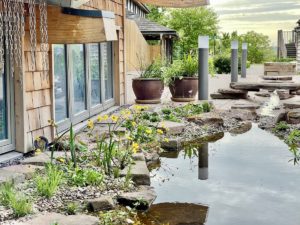Making a feature of rain…
Did you know? 85% of the UK’s drinkable water is used to flush toilets.
It accounts for about a third of household water usage; we probably waste as much water in a day as we drink in a whole month!
Earth Trust is demonstrating how things can be done differently…
At Earth Trust Centre, our Earth Lab building has been designed to use water recovered from the landscape, via a wildflower meadow roof.

Image credit: Agile Design UK
With no gutters or drainpipes, the roof is designed to enable rainwater to run off into a pool at the front of the building. Part urban drainage, part garden it makes a beautiful rainwater feature and provides a valuable wildlife habitat.
In heavy rainfall, we harvest the rainwater as it flows down the channel (rill) and into an underground storage tank. The water in the tank is used to flush the toilets in the building, and when it’s especially dry it can be pumped back up to the wildflower roof garden to water the plants.
The roof of Earth Lab is made of a specially engineered substrate, made up of recycled compost and reject brick and stone. We planted an initial selection of local wildflower plants, but it’s birds (ie their droppings) that will determine what grows there. Over time it will become the roof it wants to be, as nature rewilds it.
Why harvest rainwater?
Water is a precious resource and water features need to be managed and cared for within the context of their urban or rural landscapes, in order to effectively deliver the vast benefits they can offer;
- Improved water quality and retention
- Carbon sequestration
- Wetland habitats for biodiversity and people’s health
At Earth Trust, our rain garden is a living demonstration of one way in which industry and developers can think and act differently, as we strive to build sustainably and create truly nature-friendly spaces that enable deep connections between people and the natural world.
Have a go at creating your own rain garden
You can enjoy rainy days, knowing that it’s feeding the mini ecosystem in your own garden. It’s the perfect low maintenance plot which absorbs water more efficiently than a lawn and attracts a wider variety of wildlife to your garden.
A rain garden can be created by digging an area of shallow ground or a small hollow in a well-drained area, which receives run-off from roofs and other hard surfaces.
- Choose the shape you want (kidney shape works well) and dig 15-20cm deep. Be sure to check that there aren’t any water or gas pipes in your chosen area before you start digging.
- The soil you dig out can be used to make the berm (the lip or bund on three sides). This will keep the water in the rain garden, so has to be well-compacted, around 30cm (1ft) wide and 10cm (6in) in height.
- Leave a notch in the berm, with a gravel-filled channel for the water to exit into a conventional drainage system.
- Choose plants that can tolerate being waterlogged for around 48 hours. Low growing iris, water forget me not and a native bog bean and other aquatic plants are ideal. More drought-tolerant foliage can be planted around the edges to decorate.
Your raingarden will create a perfect habitat for insects, which in turn will encourage birds and bats to your garden. Birds will come for a drink and a bath, and you may even spot the odd dragonfly or toad!
Capturing rainfall like this helps to reduce flood risk at a property and can save money by reducing your water usage. Collecting rainwater in a water butt is a great way to minimise the impact of heavy rainfalls and it’s better for your plants too as the water has a balanced ph and is free of chemicals such as chlorine.
Find more water saving tips at the Water Wise website